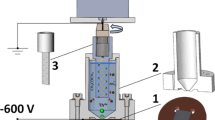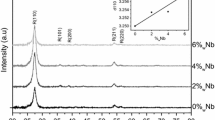Abstract
The increase of the accuracy of optical frequency standards by means of the development of nuclear clocks a novel frequency standard based on the nuclear transition to the long-living isomer nuclear state of Th-229 with energy ~7.6 eV is of great interest. The main problem is the fact that there are no experimental data on the direct measurement of the energy of the isomeric transition in Th-229, and the above result was obtained only by indirect measurements, and has great uncertainty. Low energy ion scattering spectroscopy might be used for more precision investigations of the isomeric transition in Th-229. It is caused by the fact that ion scattering spectra exhibit the fine structure determined by the target surface electronic structure. In the case of low energy nuclear transition it can give the information about the isomer nuclear state of Th-229. To prove this supposition it is necessary to prepare high quality samples with a high thorium surface coverage. An original preparation technique of the thorium films by electrochemical deposition from thorium nitrate solution on Si(111) substrate is reported. It was found that electrochemical deposition of Th on the semiconductor substrates leads to the formation of ThSiOx island films. The origin of the observed thorium films formation and the results on the investigation of 229Th and 232Th films on Si(111) surface by X-ray photoelectron spectroscopy and low energy ion spectroscopy discussed.





Similar content being viewed by others
References
Beck BR, Becker JA, Beiersdorfer P, Brown GV, Moody KJ, Wilhelmy JB, Porter FS, Kilbourne CA, Kelley RL (2007) Phys Rev Lett 98:142501
Campbell CJ, Radnaev AG, Kuzmich A, Dzuba VA, Flambaum VV, Derevianko A (2012) Phys Rev Lett 108:120802
Peik E, Tamm C (2003) Europhys Lett 61:181
Tkalya EV, Zherikhin AN, Zhudov VI (2000) Phys Rev C 61:064308
Campbell CJ, Steele AV, Churchill LR, DePalatis MV, Naylor DE, Matsukevich DN, Kuzmich A, Chapman MS (2009) Phys Rev Lett 102:233004
Porsev SG, Flambaum VV (2010) Phys Rev A 81:042516
Rellergert WG, DeMille D, Greco RR, Hehlen MP, Torgerson JR, Hudson ER (2010) Phys Rev Lett 104:200802
Hehlen MP, Greco RR, Rellergert WG, Sullivan ST, DeMille D, Jackson RA, Hudson ER, Torgerson JR (2013) J Lumin 133:91–95
Campbell CJ, Radnaev AG, Kuzmich A (2011) Phys Rev Lett 106:223001
Rellergert WG, Sullivan ST, DeMille D, Greco RR, Hehlen MP, Jackson RA, Torgerson JR, Hudson ER (2010) IOP Conf Ser Mater Sci Eng 15:012005
Borisuyk PV, Vasilyev OS, Krasavin AV, Lebedinskii YY, Troyan VI (2014) Colloid J 76:514–521
Lebedinskii Y, Zenkevich A, Pushkin M, Barantsev N, Troyan V, Nevolin V (2006) Nato Sci Ser Ii Math Phys Chem 220:323–330
Souda R, Aizawa T, Oshima C, Otani S, Ishizawa Y (1989) Phys Rev B 40:4119
Souda R, Yamamoto K, Hayami W, Aizawa T, Ishizawa Y (1995) Phys Rev B 51:4463
Souda R, Hayami W, Aizawa T, Ishizawa Y (1993) Phys Rev B 48:17255
Acknowledgments
The work was supported by Russian Foundation for Basic Research (Projects 12-08-01098 and 14-08-00487) and by Ministry of Education and Science of the Russian Federation in the frame of the government task no. 3.1803.2014/K.
Author information
Authors and Affiliations
Corresponding author
Rights and permissions
About this article
Cite this article
Borisyuk, P.V., Vasilyev, O.S., Krasavin, A.V. et al. Preparation technique of thorium films by electrochemical deposition for nuclear optical frequency standard based on thorium-229. J Sol-Gel Sci Technol 73, 580–585 (2015). https://doi.org/10.1007/s10971-014-3533-z
Received:
Accepted:
Published:
Issue Date:
DOI: https://doi.org/10.1007/s10971-014-3533-z




